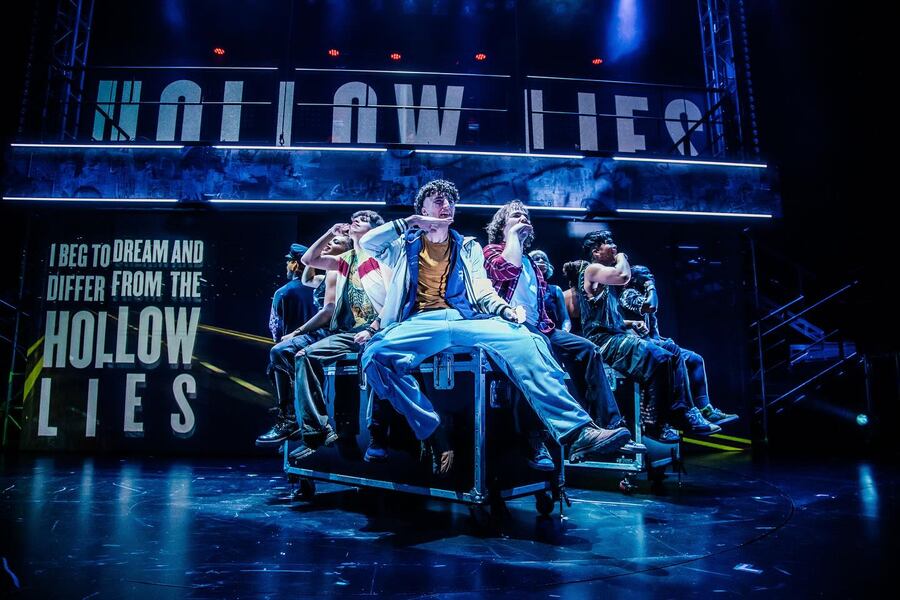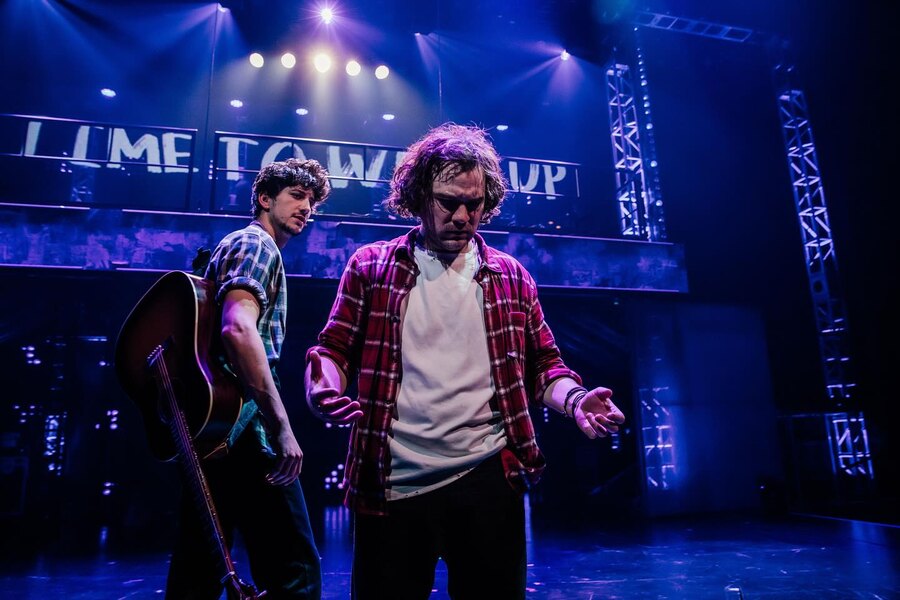Daniel Durant (right) and Milo Manheim (left) as Johnny in Deaf West and CTG’s ‘American Idiot.’ (Photo by Jeff Lorch.)
Green Day’s concept album-turned-rock opera, American Idiot, turns 20 this year, and now a new Los Angeles production is bestowing new resonance on its opening lyrics: “Don’t wanna be an American idiot/Don’t want a nation under the new media/And can you hear the sound of hysteria?”
Many actors and artists involved in the new Deaf West Theatre and Center Theatre Group production, running through November 10 at the reopened Mark Taper Forum, can’t literally hear that sound. Instead they’re devising ways to feel and convey it. In many ways, this loud punk-rock show is the perfect musical to be told in an integrated ASL and spoken English, with a cast of Deaf and hearing actors.
“In the modern society we’re in today, people have been listening to that music and have grown up with access to it,” said DJ Kurs, artistic director of Deaf West. “In this generation of Deaf youth, they’re growing up with music as part of their lives much more than we did before. American Idiot is coming from people who are misunderstood, and that fits us for sure. That describes Deaf people to a tee.”
Many know Deaf West’s work from another momentous rock Broadway musical in 2015, Spring Awakening. Indeed, the show’s co-producers, Deaf West and Center Theatre Group, have long been innovating the form of musical revivals, having begun their partnership with Big River, which transferred to Broadway in 2003. That production was nominated for two Tony Awards, including Best Revival of a Musical and won a Tony Honor for Excellence in Theatre.
The newest revival kicks off director Snehal Desai’s first full season as artistic director of CTG. Desai wasn’t just thinking about American Idiot’s timeliness with the record’s 20th anniversary and the presidential election when he programmed it. He began by considering communities not represented by punk or rock, initially from the perspective of an Asian American, then wondered what it would mean to encounter punk and rock through a Deaf lens. He took the idea to Kurs, who told him that rock and punk are access points for expression in the Deaf community, and that particularly these days on social media, you can find many Deaf artists doing covers of Green Day and other punk songs.
American Idiot, which originally opened on Broadway in 2010, is a sung-through musical about three friends unhappy in their suburban lives. Johnny turns to drugs and city life, Tunny is lured by the military, and Will stays home with his pregnant girlfriend. In this new production, all three of these lead characters are Deaf, bringing new layers to the story without changing a word of the lyrics. Consider Tunny wanting to join the military, which still doesn’t allow Deaf people to enlist.
Said Daniel Durant, who starred in Spring Awakening and plays Johnny in this production, “American Idiot is really addressing the oppression that Deaf people face everyday, saying, Hey, wake up! This is our America. Look at these systems, and how they’re not accommodating us. They’re not here for us. And you’re the American idiots.”
The production also highlights different types of relationships between Deaf and hearing people. Will’s girlfriend Heather and Jonny’s love interest, Whatsername, are both hearing, and they approach this communication barrier and learn ASL with varying degrees of willingness.
The show’s time period has been updated to the present day, incorporating modern technology. Though the album was written as a response to 9/11, the presidency of George W. Bush, and the Iraq War, its sentiments remain relevant. In recent concerts, Green Day has adjusted the lyrics, “I’m not part of a redneck agenda” to “I’m not part of a MAGA agenda.”
“The rage of the original American Idiot was this frustration and anger against society, against political empires, against oppression,” says ASL choreographer Colin Analco. “When we think about what it means to the new generation, it’s a different kind of rage.”
Milo Manheim, the lead in the Disney Channel’s musical franchise Zombies, joins Durant as Johnny’s singing voice. At 23 years old, he’s not much older than the album, but he grew up listening to it in his mom’s car. “I’ve found many reasons to be upset with this American political system structure,” said Manheim. “And now, coming back to this album, it’s kind of, in a weird way, like a welcome home, like a hug. We understand this frustration and this angst. It may not be specifically because of the events in 2001, but there are so many things to be upset and angry, misunderstood, not heard about. And so many reasons in America to feel like you want to scream. And I think part of the beauty of this show is a) honoring the original purpose and b) it’s timeless, and it really works whenever.”
Unlike other musicals with Deaf and hearing actors, wherein each role would include one signing actor and another speaker actor, the dual roles in American Idiot go even deeper, representing internal conflicts within each character. “How I see it, it’s two characters in one head,” said Durant. “It’s the same head, and two different voices.”
Added Manheim, “At some moments, I see us as best friends. At some moments, I see him being a cheerleader, or wanting what’s best for him, but feeling like his voice isn’t being heard. I think this moves throughout the course of the show, and I think each audience member might interpret it differently, but the overall theme is this angel and devil sitting on Johnny’s shoulder.”
Manheim also notes that this dynamic can be seen as a way to personify addiction. “There are many times in the show where a part of Johnny wants to do this drug, and a part of him doesn’t,” he said. “I think that’s a big theme of addiction in general, is being torn within yourself.”
This musical is entirely sung-through, so part of the creative process has been figuring out how to visually translate the rage and frustration of rock and punk into movement. That falls to choreographer Jennifer Weber and ASL choreographer Colin Analco.
“We can use ASL to interpret the words that are said, but also, what about the beautiful violins? What about the drums? What about the guitars? How do we bring that to life, so people who can’t hear the music can see the music?” Weber wondered. “One of the things that’s interesting and exciting about this production is that we’re using our bodies to be the music and to be loud. We are literally like being as loud as Green Day with this amazing, diverse cast of people. In how we physicalize the energy of that, there’s something beautiful and abstract and chaotic.”
Weber and Analco work together to blend the ASL and dance choreography. “I love that there are some moments where Jen will look at me and ask, ‘What’s the sign for this?’” said Analco. “Based on the sign that I give her, there’s a dance she’ll come up with. And it goes vice versa too: ‘What is the choreography for this? Okay, fine. Let me take a sign and incorporate it.’ One of my biggest goals is for the audience to not see the same thing over and over again. I want to see diversity onstage—growth, movement, staging—and make sure that the narrative is telling it in that way.”

Though Deaf West musicals have mostly been acclaimed, they have also been met with backlash. “I think that our community has accepted music as part of our fabric of expression, whereas before, when we did our first big musical, people protested on the street in front of the theatre because they felt that music was not part of Deaf culture,” Kurs recalled. “That is how far we’ve come, where we have so many talented, brilliant, expressive young Deaf artists to make a production like this.”
Deaf West productions have also been criticized for not being fully accessible to Deaf audiences and catering more towards a hearing audience. Explained Kurs, “We approach every performance we do to make it as accessible as possible. We want to make good theatre, period. That’s for both Deaf and hearing people to enjoy. It’s easy to confuse art with accessibility, and we want to make certain that if we’ve done everything the right way, the message is clear. Then the story will resonate with both audiences.”
It helps that American Idiot is not naturalistic and the story is open to interpretation. “The rules for the world are not going to be realistic worlds of time and space and understanding,” said Desai. “We want to make sure that everyone can access the show and go for the ride. There are sometimes moments where it is just about heightened emotion and energy, and it’s not about realistically what is happening in the scene moment to moment.”
Ultimately, Desai hopes that this production will allow audiences to see the world through someone else’s eyes.
“I think what’s beautiful about our production is that there are moments where there are these separations between the communities, and then there’s moments where it is seamless, and you don’t know who is Deaf or who is hearing, and they are all together communicating and expressing themselves. And we’re living for a moment free of these barriers,” he said. “That’s the hope: that everyone’s being seen for who they are, and not (just) that they’re Deaf, or that they are hearing, or that they are a person of color, or for their sexual orientation, or anything like that. The world just blurs in this beautiful way.”
Linda Buchwald (she/her) is a theatre and television journalist based in Los Angeles who has written for TheaterMania, Playbill, TDF Stages, Kveller, and more. On Twitter: @PataphysicalSci.


